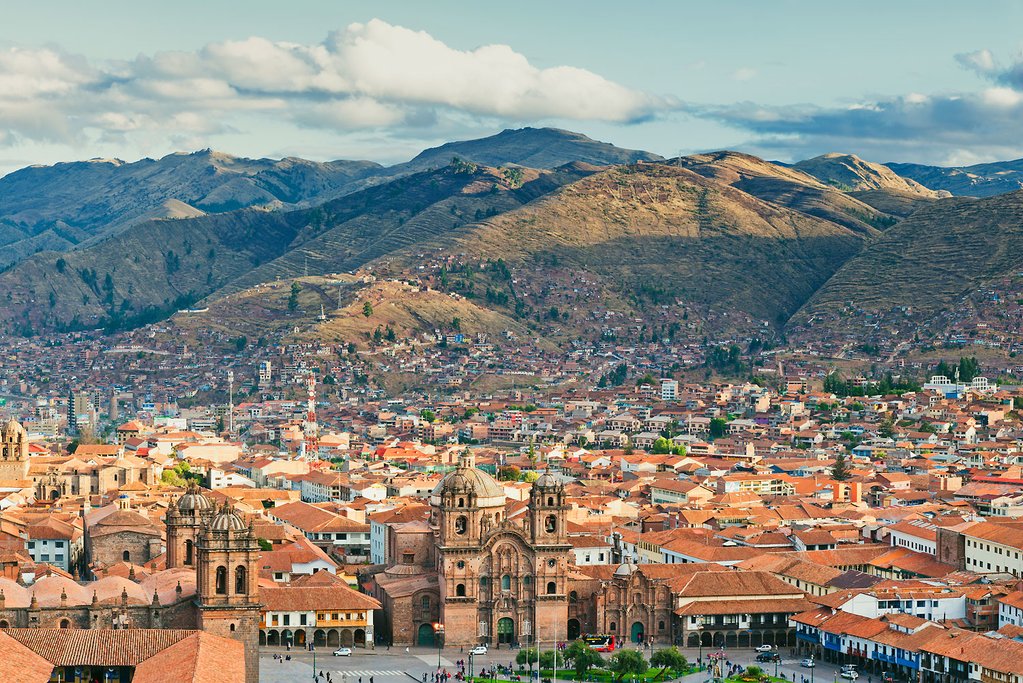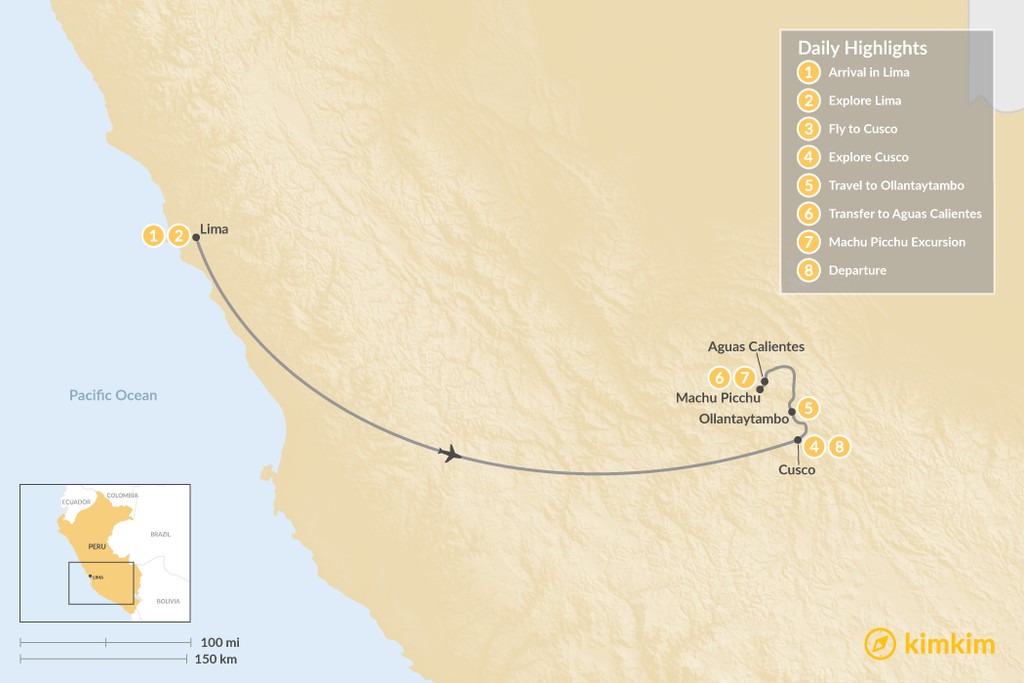
Peru Highlights Adventure - 8 Days

Highlights
- Take a culinary tour in metropolitan Lima
- Get to know Cusco, the ancient Incan capital
- Enter Machu Picchu via a stretch of the Inca Trail
- Visit the Moray salt flats on a Sacred Valley excursion
Brief Itinerary
| Day | Highlights | Overnight |
|---|---|---|
| Day 1 | Arrival in Lima | Lima |
| Day 2 | Lima City & Food Tour | Lima |
| Day 3 | Arrival in Cusco, Transfer to Hotel | Cusco |
| Day 4 | Cusco: Free day to Explore | Cusco |
| Day 5 | Sacred Valley Tour: Cusco - Chinchero - Ollantaytambo | Ollantaytambo |
| Day 6 | Short Inca Trail to Machu Picchu: Ollantaytambo - Aguas Calientes | Aguas Calientes |
| Day 7 | Machu Picchu Excursion: Aguas Calientes - Machu Picchu - Cusco | Cusco |
| Day 8 | Departing Cusco |
Detailed Itinerary
Day 1: Arrival in Lima

Welcome to Lima, Peru's largest city and central metropolitan hub, and home to one-third of the country's population. Located at the site of a pre-Columbian indigenous Ychsma settlement, which was conquered by the Inca empire in the 15th century and later by the Spanish conquistadores, Lima has a fascinating history and a diverse mix of cultures. Amerindian, European, Afro-Peruvian, and Asian—especially Chinese and Japanese—influences make Lima a dynamic and exciting city to explore.
Lima's breezy location on the Pacific Ocean and mild desert climate make it the perfect city for exploring on foot. Head downtown to mingle with locals, stretch your legs, and grab a bite to eat in one of the many award-winning restaurants.
Suggested activities include:
- Explore the historic center of Lima, a UNESCO World Heritage Site packed with fascinating Spanish architecture. Start with a scenic tour of the colonial downtown, which emanates from the main square. Stroll over to the 16th-century Cathedral, which took 80 years to construct and was built in the grandiose style of the Spanish Empire.
- Visit the Casa Aliaga, a colonial mansion granted by chief conquistador Francisco Pizarro to Jerónimo de Aliaga, one of his captains, in 1535. This is the only house from that era that still belongs to the same family.
- Stroll around the Pueblo Libre district to the privately owned Larco Museum of pre-Columbian art, housed in a beautifully restored viceregal mansion built over a 7th-century pre-Columbian pyramid. The museum boasts a vast pre-Colonial collection of gold and silver artifacts, as well as pieces of erotic art.
- In the evening, head to the eclectic "Love Park" in the upscale coastal district of Miraflores, where you can admire a huge kissing statue and beautiful mosaic walls. The park is built on the cliffs of Chorrillos and is a perfect place to enjoy a spectacular sunset over the Pacific.
- Enjoy a nightcap at an open-air cafe or restaurant in the diverse Miraflores neighborhood.
Day 2: Lima food tour

Spend the day discovering Lima through its food. With a vibrant combination of Indigenous American, African, Asian, and European culinary influences, Lima is one of the world's most impressive gastronomic and cultural centers.
Start the day early in Lima's historical center to visit a local mercacado—a fresh food market—to taste the local produce and sample spices, fruits, and various baked bread. Taste different types of Piscos—a high proof brandy produced locally in the wine-making regions of Peru and Chile. Attend a cooking class and learn how to make ceviche, a fresh seafood dish marinated with salt and lime juice, and the traditional pisco sour—a Peruvian classic.
Stop for lunch at one of Lima's top restaurants and enjoy a delicious meal on a patio overlooking the Pacific ocean. Stroll to the bohemian district of Barranco—a popular oceanside neighborhood for artists, tourists, and locals alike—for a relaxed afternoon drinking coffee and sampling Peruvian desserts.
Day 3: Arrival in Cusco

Head to the Lima airport for your transfer flight to Cusco.
Remember: you will be 11,000 feet (3,000 m) above sea level, so take it easy and remember to drink lots of water. Take a walk through the plaza — if the weather is beautiful, it's a perfect place to sit and have a cup of coca tea while adjusting to the elevation.
In the evening, take the opportunity to experience Cusco's celebrated culinary heritage at a local restaurant.
Chat with a local specialist who can help organize your trip.
Day 4: Free day in Cusco

Today you will explore Cusco and the surrounding ancient ruins. Since Cusco was designed by the Incas as a city for walking, start your exploration of the narrow stone alleyways on foot.
Suggested activities include:
- Visit the Coricancha, also known as "The Temple of the Sun." The temple was built by the Incan Emperor Pachacutec (1438 - 1572), and after the arrival of the Spaniards became the basis for the construction of the Santo Domingo Convent.
- See the Cathedral, the most imposing monument in the central Plaza de Armas and a repository for Cusco's colonial art. Its construction lasted for almost 100 years, beginning in 1560 and ending in 1654.
- Walk to Sacsayhuamán and next-door Quenqo, both archaeological complexes used mostly for religious and agricultural rituals, located 2.5 miles (4 km) from the city of Cusco. Built by the Killke people, Sacsayhuamán is a marvel of ancient architecture, a monolithic fortress built from giant blocks of stone, the origins and assembly of which remain a mystery.
- Discover the elaborate Puca Pucara ruins—an architectural complex of alleged military use with multiple plazas, baths, aqueducts, walls, and towers. It is believed that the entourage of the Incan emperor used it while he stayed at Tambomachay, the elaborate estate and baths nearby.
- Explore San Blas, an old bohemian quarter famous for its picturesque white walls, blue doors, and creative artisan community.
- Experience the legendary Mercado Central de San Pedro, a large and diverse market famous for its mouth-watering juices, home-style meals, medicinal herb stalls, and rows of various meats, loaves of bread, vegetables, and other necessities.
- Eat lunch at a local Peruvian restaurant and sample local flavors and cooking techniques—crackling pork, pickled vegetables, seasonal flavors, bread baked in earthen ovens, roasted vegetables, and sweet donuts make for a delicious and filling meal.
Day 5: Sacred Valley Tour - Cusco, Chinchero, Ollantaytambo

Today you will depart from your hotel in Cusco for a visit to the village of Chinchero, believed by the Inca to be the birthplace of the rainbow. You will see extensive Inca terraces and several small colonial-era churches, before exploring Chinchero's famous textile production and weaving crafts. Tour a weaver's studio and learn about the process of cleaning and producing the wool, then browse the selection of vibrant textiles for the perfect handmade gift.
Continue to Moray, a series of incredible stone amphitheaters built by the Inca. Considered one of the world's most innovative and architecturally advanced cultures, the Inca likely used these stone complexes for experimental agriculture in micro-climates.
From Moray walk (or take a bus) to the Salineras—the Moray Salt Flats—an intricate network of stone pools developed by the Inca to harvest salt through evaporation. These salt flats are still in use today and are carefully maintained by a close community with regulations and rules that date back to the time of the Inca.
Spend the night in the small historic town of Ollantaytambo, high in the Sacred Valley. Explore the surrounding stone fortresses, archeological ruins, and cobblestone streets of the town, which remain remarkably intact similar to their original appearances after construction by the Inca.
Day 6: Short Inca Trail to Machu Picchu - Ollantaytambo to Aguas Calientes

Early in the morning, we will take the train from Ollantaytambo to Km 104 where the short Inca Trail starts. By train, we see how the valley turns into a canyon and the scenery begins to alter as the cloud forests appear on our approach to Machu Picchu. We will disembark the train at Km 104 and start the hike along a challenging uphill path.
Start the trek to your first archeological site—Chachabamba. This beautiful site is very well preserved thanks to its location in the valley and was likely used for religious purposes and as a gatekeeping point for this entrance to Machu Picchu.
From here ascend for 3 hours to the ruins of Wiñay Wayna (2732 m / 8964 ft), an ancient rest area for travelers on the Inca trail. Here, we'll stop to enjoy our delicious boxed lunch, with superb views of the massive green mountains and native orchids.
The trail then becomes gentler and continues through the semi-tropical cloud forest to Intipunku (Sun Gate) where you'll enjoy your first panoramic views of Machu Picchu. Descend half an hour to the citadel for a short break and an opportunity for photos.
We won't be exploring the ruins today, as it will be getting dark. After passing through the Sun Gate, we'll cross the site to take the bus down to Aguas Calientes, where you'll check into our hotel to rest and relax in anticipation of a full-day visit to Machu Picchu tomorrow.
Maximum Altitude: 2732 m / 8964 ft
Minimum Altitude: 2088 m / 6850 ft
Distance Travelled: 10.79 km / 6.67 ml (to Inti Punku)
Approximate Walking Time: 7 hours
Day 7: Machu Picchu excursion: Aguas Calientes - Machu Picchu - Cusco

Today we will catch the bus up to Machu Picchu to enjoy the ruins. It is a 25-minute bus ride to the sanctuary of Machu Picchu (2400 m). Our guide will lead us in our exploration and discovery of the many curious corners within the enigmatic Citadel of Machu Picchu. The guided tour will have an average duration of 2 hours.
Afterward, you will still have some time to visit other places that you did not see with your guide. For example, heading west from the center of Machu Picchu, the Inca bridge is a 30 minute / 2 Km or so walk along a narrow path. If you feel like an uphill challenge, you have the option to climb the infamous Huayna Picchu or Machu Picchu mountain. It is important to know that to climb these peaks, you need to buy separate tickets in advance.
At the end of our visit, we will take the bus down to Aguas Calientes for lunch and then board the train to Ollantaytambo. On arrival, we will be met by our driver who will transfer us to our hotel in Cusco.
Day 8: Departing Cusco

Today is your last day in Peru. You will be met at your hotel for a transfer to Cusco Airport, where you will transfer to your international departure. ¡Buen viaje!
